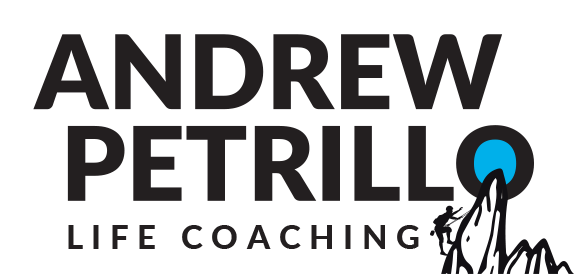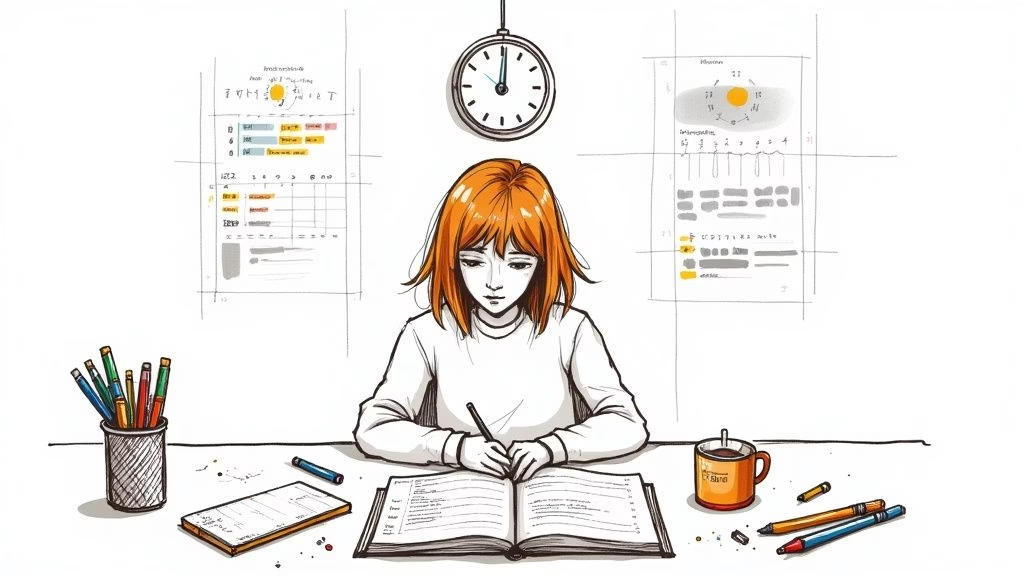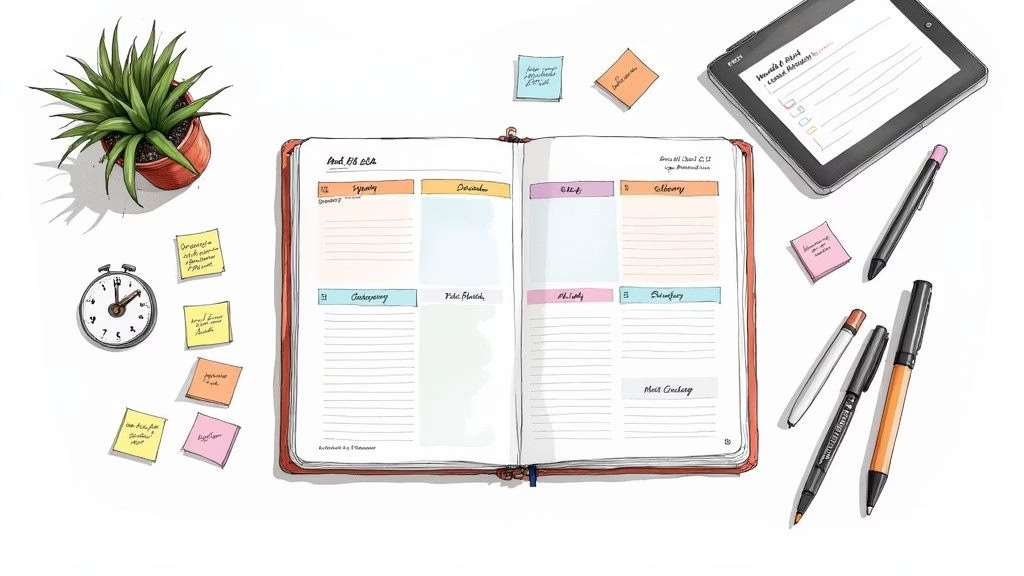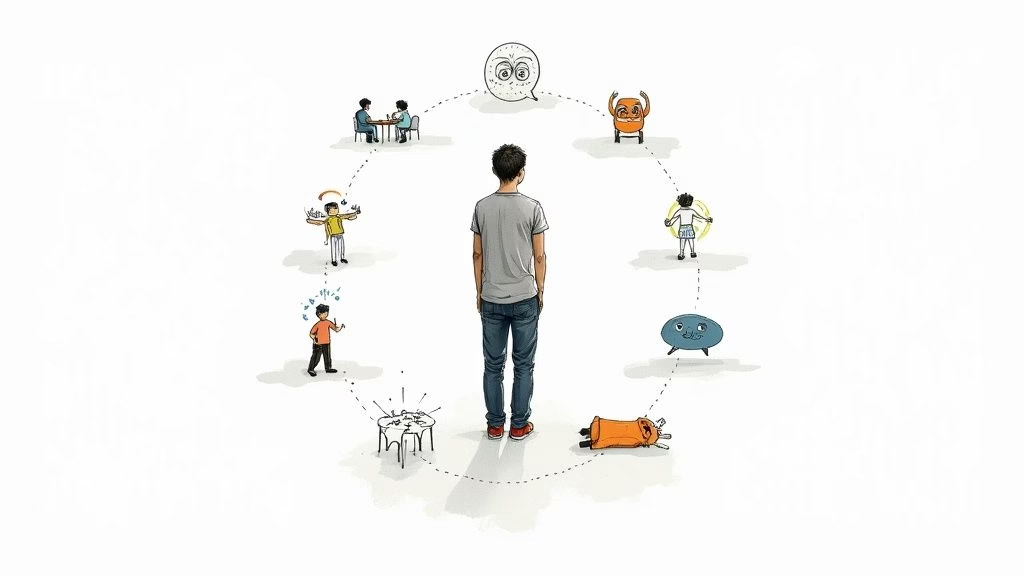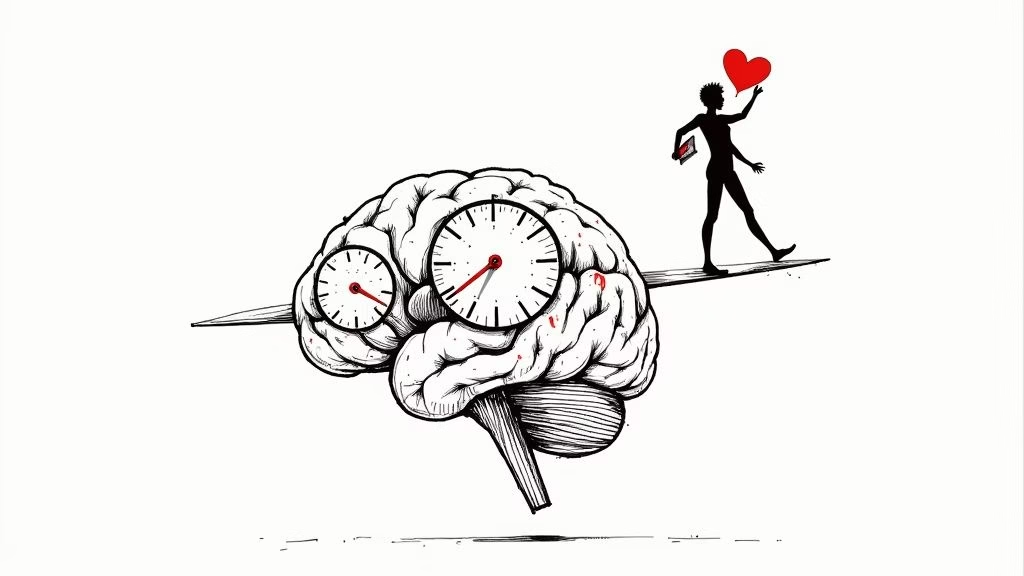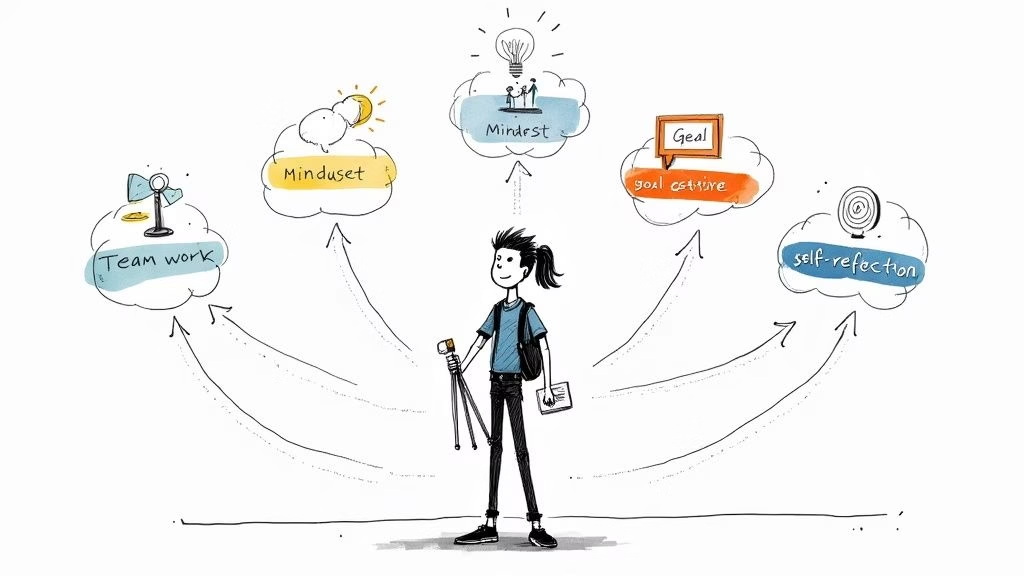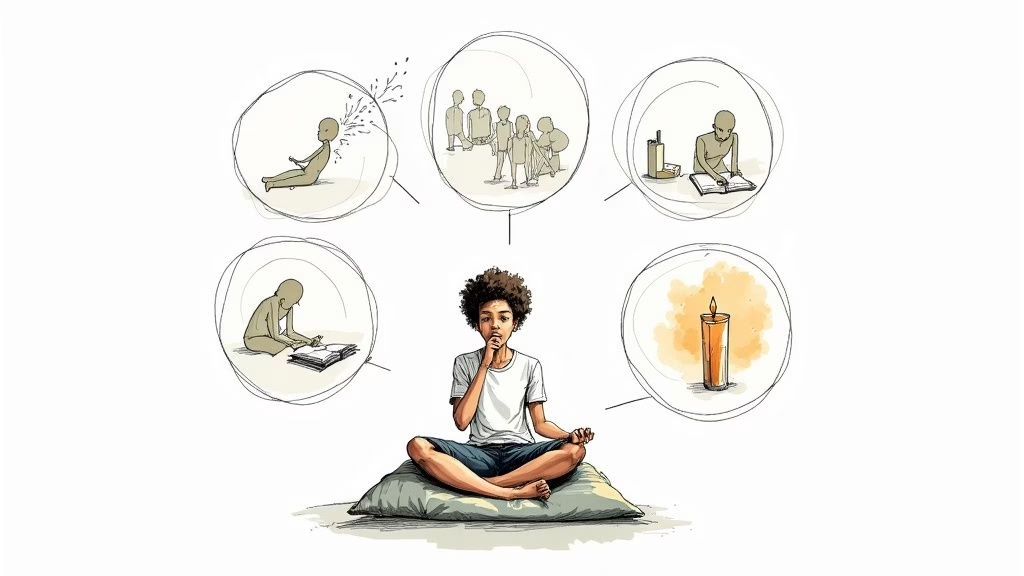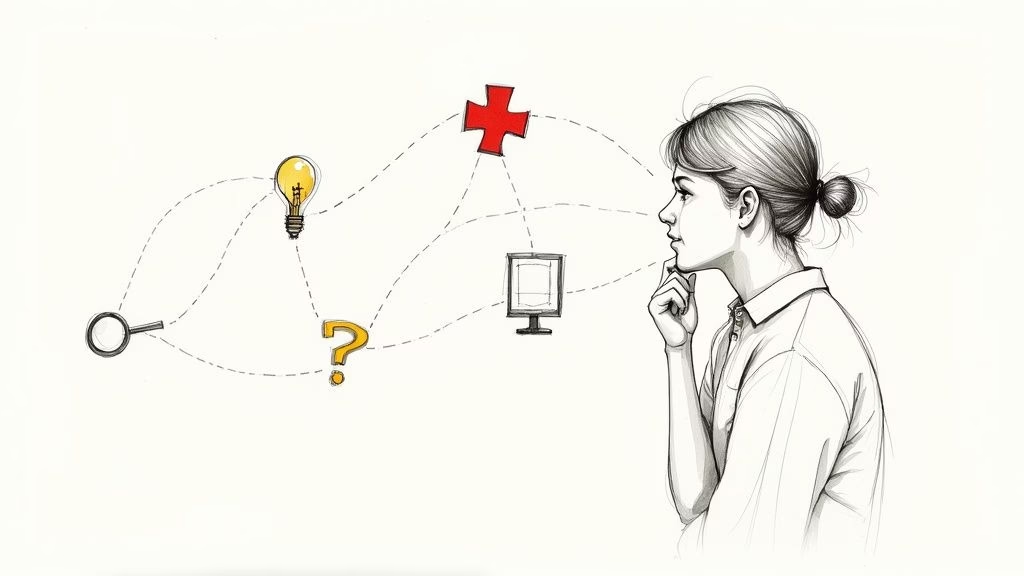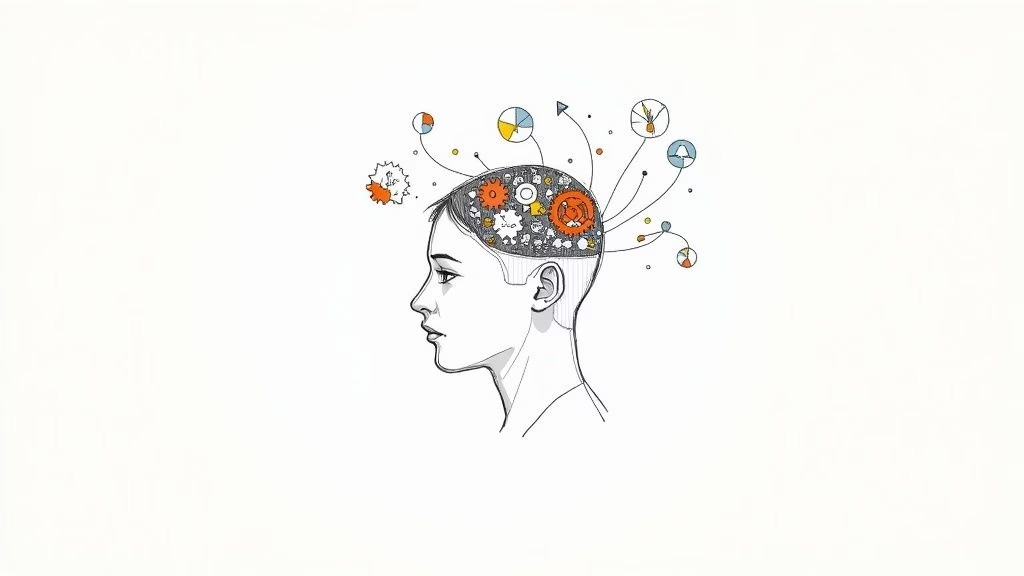High school isn't just about memorizing facts for the next exam; it's about learning how to learn. Many students, and often their parents, feel the immense pressure of rising expectations, the paralyzing grip of procrastination, and a constant struggle with motivation. The old advice to simply 'study harder' is outdated and ineffective. True academic success comes from studying smarter, using strategies that align with how our brains actually retain information. This guide provides a deep dive into nine proven study skills for high school students, each designed for the modern academic landscape.
We'll move beyond passive techniques like rereading textbooks and highlighting passages. Instead, we'll explore powerful, research-backed methods that build genuine understanding, enhance long-term retention, and help you manage stress effectively. For parents, we'll weave in practical tips to support your teen's journey, fostering a healthier and more productive learning environment at home. These strategies are more than just study hacks; they are foundational skills for building academic confidence that extends far beyond graduation. Before we dive into specific techniques, it's crucial to have a solid framework. Mastering a few actionable student organization tips can significantly amplify the effectiveness of every method we cover.
1. Active Recall: Your Brain's Superpower for Long-Term Memory
Forget passively highlighting or re-reading your textbook until the words blur. One of the most effective study skills for high school students is Active Recall, a method that involves deliberately retrieving information from your brain. Instead of just reviewing material, you actively test yourself, forcing your mind to pull out the facts. This process of struggling to remember strengthens the neural pathways associated with that information, making it stick for the long term.
The reason this technique combats procrastination is its efficiency. You quickly identify what you actually know versus what you just recognize, so you stop wasting time on familiar concepts. For parents looking to support their teen, encouraging this method can transform study sessions from a source of stress into a productive challenge, directly helping to improve academic performance.
How to Implement Active Recall
Getting started is simple. Instead of re-reading a chapter on the American Revolution, close the book and try these techniques:
- The Blank Page Method: Grab a blank sheet of paper and write down everything you can remember about the topic without peeking at your notes. This immediately reveals gaps in your knowledge.
- Create Your Own Quizzes: As you finish a lesson, write down 3-5 questions you think might be on a test. Use these later to quiz yourself.
- Use Flashcards: Create physical or digital flashcards (using apps like Anki) for key terms, dates, or formulas. The key is to force yourself to state the answer before you flip the card.
To further harness your brain's superpower for long-term memory, explore more powerful methods of actively retrieving information with these additional active recall techniques.
2. Spaced Repetition: Outsmarting Your Brain's Forgetfulness
Cramming for an exam the night before is a classic high school ritual, but it’s also one of the least effective study skills for high school students. Spaced Repetition offers a smarter alternative by working with your brain's natural tendency to forget. This technique involves reviewing information at increasing intervals over time. You review a concept right before you’re about to forget it, which interrupts the "forgetting curve" and cements the information more deeply into your long-term memory.
This method directly combats the overwhelm that fuels procrastination. Instead of facing a mountain of information, you tackle it in small, scheduled, and manageable chunks. For parents, encouraging this approach helps teens build consistent study habits rather than relying on stressful, last-minute cram sessions. It transforms studying from a daunting task into a sustainable routine, which is a cornerstone of effective time management for students.
How to Implement Spaced Repetition
The key is to review information strategically, not just randomly. Here’s how to get started:
- Use the Leitner System: Create several boxes for your flashcards. When you answer a card correctly, it moves to the next box (which you'll review less frequently). If you get it wrong, it moves back to the first box (for daily review).
- Leverage Digital Tools: Apps like Anki or Quizlet have built-in spaced repetition algorithms. They automatically schedule when you need to see each flashcard, taking the guesswork out of the process.
- Create a Review Calendar: For larger topics like history chapters or biology units, manually schedule your reviews. For example, review one day after learning, then three days later, then a week later, and finally a month later.
3. The Pomodoro Technique: Mastering Focus in 25-Minute Sprints
Facing a five-page essay or a mountain of math problems can feel so overwhelming that it’s easier to just scroll through social media instead. The Pomodoro Technique is a powerful time management method that breaks this cycle. It structures work into focused, 25-minute intervals (called "pomodoros") separated by short 5-minute breaks. After four pomodoros, you take a longer, more restorative break of 15-30 minutes. This approach makes large tasks feel manageable and respects your brain's natural attention span.
This method directly combats mental fatigue and is one of the most effective study skills for high school students battling procrastination. For parents, encouraging your teen to try this technique can help them build momentum on projects they've been avoiding. While the Pomodoro Technique is excellent for managing time, you can also explore broader proven strategies to overcome procrastination to build a more comprehensive set of habits.
How to Implement the Pomodoro Technique
To get started, all you need is a timer. Pick a single task to focus on, set your timer for 25 minutes, and begin.
- Plan Your Pomodoros: Before starting, break down your study session. For example, assign one pomodoro to outlining an essay, the next to writing the introduction, and another to reviewing chemistry notes.
- Use a Dedicated Timer: A physical timer or a focused app (like Forest or Be Focused) works better than your phone’s clock, which can be a source of distraction.
- Handle Interruptions: If a thought or distraction comes up, quickly jot it down on a piece of paper and immediately return to your task. Address it during your break.
- Protect Your Breaks: Your breaks are for recharging. Step away from your desk, stretch, or grab a snack. Avoid checking your phone, as it can pull you out of your focused state.
To dig deeper into maintaining concentration during these intervals, discover more tips on how to focus while studying.
4. The Cornell Note-Taking System: Structured Notes for Better Recall
Disorganized, messy notes can be a major source of study-related stress and procrastination. The Cornell Note-Taking System offers a structured, systematic method to capture, organize, and review information effectively. This approach divides your page into three distinct sections, turning the passive act of listening into an active process of engagement. By organizing your thoughts as you learn, you create a powerful study tool from the very start.
This system is one of the most effective study skills for high school students because it builds a review process directly into your note-taking. For parents, encouraging your teen to adopt this method can reduce the overwhelming feeling of facing a mountain of disorganized notes, making exam preparation feel more manageable and less anxiety-inducing.
How to Implement the Cornell Note-Taking System
To get started, divide a piece of paper into three sections: a main notes column on the right (about 6 inches), a narrower cues column on the left (about 2.5 inches), and a summary section at the bottom (about 2 inches).
- Main Notes Column: During a lecture, take your detailed notes in this large, right-hand column. Focus on capturing key ideas, examples, and formulas. Use abbreviations and symbols to keep up.
- Cues Column: As soon as possible after class, review your notes and pull out main ideas, keywords, or potential test questions. Write these in the left-hand cues column, directly across from the related notes.
- Summary Section: Within 24 hours, synthesize the key information from the page into a one or two-sentence summary at the bottom. This final step solidifies your understanding and makes future review incredibly efficient.
5. Mind Mapping: Visually Connecting Complex Ideas
Traditional linear notes can be restrictive, forcing your brain to process information in a way it doesn’t naturally work. Mind Mapping, a visual study skill for high school students, breaks these chains. This technique involves creating a diagram that starts with a central idea and branches out into related subtopics and details. By using colors, keywords, and images, you create a visual web of information that mirrors your brain’s natural associative thinking, making complex subjects easier to understand and recall.
This method is a powerful tool against procrastination because it turns studying into a more creative and engaging activity. For parents, suggesting mind mapping can help a teen who feels overwhelmed by a large topic see the bigger picture and how all the pieces connect. This visual organization can reduce academic anxiety and build confidence, showing them that they can tackle complex material one branch at a time. It’s a great way to make study sessions more dynamic and less monotonous.
How to Implement Mind Mapping
Turning a blank page into a powerful study tool is easier than it looks. It works exceptionally well for brainstorming essays, summarizing chapters, or connecting concepts across different subjects.
- Map Character Relationships: An English student can place a novel's protagonist in the center and create branches for other characters, detailing their connections, conflicts, and motivations.
- Visualize Historical Events: A history student can map the causes and effects of an event like the French Revolution, using different colored branches for political, economic, and social factors.
- Connect Biological Systems: A biology student can place "The Human Body" at the center and branch out to different systems like the circulatory, nervous, and digestive systems, adding key functions and organs to each.
Start with a central image, use single keywords instead of long sentences, and add small drawings to boost memory. Tools like MindMeister or even a simple notebook can get you started on this effective study journey.
6. The Feynman Technique: Master Any Subject by Teaching It
True understanding isn't about memorizing complex definitions; it's about being able to explain a difficult idea in simple terms. This is the core principle behind the Feynman Technique, a powerful four-step learning method. Developed by Nobel Prize-winning physicist Richard Feynman, this approach forces you to deconstruct complex topics into their fundamental components, revealing exactly where your knowledge is weak. It’s one of the most effective study skills for high school students because it transforms passive learning into an active process of creation and explanation.
The following infographic illustrates the core workflow of applying the Feynman Technique to deepen your understanding.
This simple, three-part flow highlights how explaining a concept, identifying knowledge gaps, and using analogies creates a powerful cycle of learning and reinforcement. The technique helps you combat procrastination because it gives you a clear, active task: explain the concept, rather than just passively re-reading it. For parents, encouraging your teen to "teach" you what they learned in chemistry or history class can be a low-stress way to implement this method and gauge their true comprehension.
How to Implement the Feynman Technique
You don't need to be a physicist to use this method. To master a concept from any class, follow these steps:
- Explain It Simply: Grab a notebook and write down the concept at the top. Then, write out an explanation as if you were teaching it to a much younger student. Use simple language and avoid jargon.
- Identify Your Gaps: As you explain, you'll inevitably get stuck or realize you can't simplify a certain part. These are the exact gaps in your understanding. Go back to your textbook or notes to fill them in.
- Use Analogies: Refine your explanation by creating analogies that connect the new idea to something you already understand well. For instance, explaining a cell's mitochondria as the "powerhouse" of the cell is a classic example.
- Review and Refine: Reread your simplified explanation. Does it make sense? Is it clear? If not, repeat the process until you have an explanation that is both simple and accurate.
7. The SQ3R Method: Reading to Understand, Not Just to Finish
Staring at a dense textbook chapter can feel overwhelming, often leading to passive reading where information goes in one ear and out the other. The SQ3R Method is a five-step reading comprehension strategy that transforms this passive process into an active, engaging one. Standing for Survey, Question, Read, Recite, and Review, this technique provides a systematic framework for deconstructing, understanding, and retaining complex material.
This method is one of the most powerful study skills for high school students because it builds a mental scaffold before the deep reading even begins, preventing that "I just read ten pages and remember nothing" feeling. For parents, encouraging this approach can help teens tackle intimidating assignments, like technical science papers or primary source documents in history, with confidence. It systematically breaks down the work, making it less likely for a student to procrastinate.
How to Implement the SQ3R Method
To apply this to your next reading assignment, like a chapter on cellular respiration, follow these five steps in order:
- Survey: Skim the chapter first. Look at headings, subheadings, bolded words, images, and the summary. Get a general sense of the landscape before you dive in.
- Question: Turn those headings and subheadings into questions. For example, a heading like "The Krebs Cycle" becomes "What is the Krebs Cycle and what is its purpose?" This primes your brain to look for answers.
- Read: Now, read the chapter actively with the goal of answering the questions you just formulated. Pay close attention to the sections that address your specific queries.
- Recite: After each section, pause and summarize what you just read in your own words. Say it out loud or jot down key notes. This is where real learning happens, moving information from short-term to long-term memory.
- Review: Once you've finished the chapter, go back over your notes and questions. Can you answer them all without looking at the text? This final pass solidifies your understanding and is crucial for retention.
8. Interleaving Practice: Mix It Up to Master It Faster
Most students study in blocks, dedicating an hour to algebra before moving on to an hour of chemistry. Interleaving Practice flips this on its head. It’s a powerful study skill for high school students that involves mixing different but related topics within a single study session. Instead of drilling one concept until you feel you've mastered it (known as "blocked practice"), you switch between different types of problems or subjects. This forces your brain to work harder to distinguish between concepts and choose the right strategy for each problem.
This initial struggle is key. It prevents the illusion of mastery that comes from repeating the same procedure over and over. By constantly shifting gears, you build a more flexible and robust understanding of the material. For parents, encouraging interleaving can help teens who feel stuck or bored with repetitive drills. It introduces variety that combats procrastination by keeping study sessions more dynamic and challenging, ultimately strengthening long-term retention.
How to Implement Interleaving Practice
You can integrate this method into your existing study routine without much extra effort. Instead of completing all your algebra homework before starting biology, try these approaches:
- Mix Your Math Problems: If you’re studying for a math final, don't just do 20 algebra problems followed by 20 geometry problems. Instead, create a practice sheet that mixes them up randomly. This mimics the format of a real exam.
- Alternate Language Arts Skills: When studying for an English test, alternate between practicing grammar rules, analyzing literary devices in a poem, and reviewing vocabulary flashcards all in one session.
- Combine Science Concepts: For a science class, mix practice questions from physics, chemistry, and biology chapters. This helps you see the connections and differences between scientific principles.
Start with small, mixed sets of problems. As you get closer to a test, increase the variety to build your mental agility and ensure you can recall the right information under pressure.
9. Dual Coding: Connecting Words and Pictures
Reading your notes over and over can feel like pouring water into a leaky bucket. Dual Coding offers a better way by engaging two parts of your brain at once: the part that processes words and the part that processes images. This study skill for high school students is based on the idea that we remember information better when it’s presented both visually and verbally. By connecting text to a drawing, diagram, or chart, you create two mental pathways to the same information, doubling your chances of recalling it later.
This method makes studying less monotonous, which can be a powerful tool against procrastination and academic burnout. Instead of passively reading, you are actively creating and connecting concepts. For parents, encouraging your teen to sketch out a concept from their history textbook isn't just about art; it’s a strategic way to boost comprehension and help them overcome feelings of being overwhelmed, a common source of academic stress.
How to Implement Dual Coding
You don't need to be an artist to make this work. The goal is to create simple, meaningful visuals that connect to the text.
- Create Timelines and Flowcharts: For a history class, don't just write down dates. Draw a timeline and add small icons or symbols for major events. For a science process like photosynthesis, create a flowchart with simple drawings at each step.
- Draw Labeled Diagrams: Instead of just listing the parts of a cell in biology, draw the cell and label its components. Explain each part’s function next to your drawing.
- Mind Mapping: Start with a central idea in the middle of a page and branch out with related concepts, using keywords, short phrases, and simple images to link them.
To learn more about how visual and verbal learning works together, explore Allan Paivio’s groundbreaking Dual Coding Theory.
Study Skills Strategy Comparison Table
| Technique | Implementation Complexity | Resource Requirements | Expected Outcomes | Ideal Use Cases | Key Advantages |
|---|---|---|---|---|---|
| Active Recall | Moderate – requires self-discipline and consistent practice | Minimal – flashcards or self-made quizzes | Strong long-term retention, identifies weak points | Memorization-heavy subjects like anatomy, languages, history | Efficient memory strengthening, easy to do anywhere |
| Spaced Repetition | High – requires long-term commitment and scheduling | Digital apps recommended for best results | Maximized retention with less study time | Language learning, exam prep, medical studies | Scientifically optimized intervals, reduces cramming |
| Pomodoro Technique | Low – simple timers and breaks structure | Timer or app helpful | Improved focus, reduced procrastination | Task-based work sessions, writing, exam prep | Enhances concentration, prevents burnout |
| Cornell Note-Taking System | Moderate – needs familiarity with format | Pen and paper or digital notes | Organized notes and improved review efficiency | Lectures, note-heavy courses, structured study sessions | Systematic notes, promotes active engagement |
| Mind Mapping | Moderate to High – requires creativity and tool use | Paper or digital mind mapping tools | Enhanced comprehension and creativity | Brainstorming, complex concept breakdowns, visual learners | Visualizes relationships, boosts creativity |
| Feynman Technique | High – time-consuming and iterative | Minimal – requires writing tools | Deep understanding, reveals knowledge gaps | Complex topics needing conceptual clarity | Builds mastery, improves teaching and communication skills |
| SQ3R Reading Method | Moderate – involves multiple structured steps | Text material and note-taking tools | Better reading comprehension and retention | Dense textbooks, academic reading | Systematic active reading, improves key information recall |
| Interleaving Practice | High – demands careful planning and mixing of topics | Variety of problem sets or topics | Improved transfer of skills and problem-solving | Math, languages, sciences requiring mixed practice | Encourages flexible thinking, improves discrimination skills |
| Dual Coding | Moderate to High – requires combining visuals and text | Creation of diagrams, charts, or images | Enhanced memory through multiple sensory pathways | Spatial, scientific, and technical subjects | Appeals to varied learning styles, boosts understanding |
Putting It All Together: A Parent's Guide to Supporting Teen Success
Navigating high school academics is a complex journey, and the study skills we’ve explored are the tools that can transform a challenging path into a successful one. From leveraging Active Recall to defeat the forgetting curve to using the Pomodoro Technique for focused, burnout-free sessions, each strategy offers a unique advantage. Techniques like the Cornell Note-Taking System and Mind Mapping don’t just capture information; they organize it in a way that makes sense to the brain, while the Feynman Technique ensures true comprehension, not just surface-level memorization.
For parents, the goal isn't to enforce a rigid system but to foster an environment of exploration and support. Your role is that of a guide, helping your teen discover which combination of these powerful methods works best for their unique learning style. Encourage experimentation, celebrate the effort they put in, and focus on the small victories along the way. Mastering these study skills for high school students is less about achieving a perfect grade and more about building a foundation of confidence, resilience, and a love for learning.
Bridging the Gap Between Skill and Motivation
It is crucial to recognize that even the best study plan can fall apart without the right mindset. Procrastination and a lack of motivation are often not signs of laziness but symptoms of underlying challenges like overwhelming stress, anxiety, or a fear of failure. Open, non-judgmental conversations about mental well-being are just as important as discussions about homework.
Create a safe space for your teen to talk about the pressures they face. Validate their feelings and work together to find healthy coping mechanisms. Remember, academic success and mental health are deeply intertwined. For expert guidance and resources, consider exploring reputable organizations dedicated to adolescent well-being.
- The Jed Foundation (JED): Offers comprehensive resources and programs to protect emotional health and prevent suicide for teens and young adults.
- National Institute of Mental Health (NIMH): Provides research-backed information on a wide range of mental health topics, including specific resources for adolescents.
By prioritizing both effective study skills for high school students and robust emotional support, you empower your teen not just to survive the academic rigors of high school, but to truly thrive, building habits that will serve them well into college and beyond.
If your teen continues to struggle with motivation, procrastination, or building effective routines, personalized guidance can make all the difference. Andrew Petrillo Life Coaching specializes in equipping students with the tools they need to overcome academic obstacles and develop lasting self-management skills. Discover how a dedicated life coach can help your student unlock their full potential by visiting Andrew Petrillo Life Coaching.
